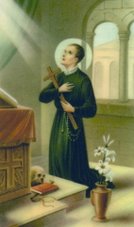 At last I have bought it. This post comes a bit late for Christmas presents, but nevertheless:
At last I have bought it. This post comes a bit late for Christmas presents, but nevertheless:David Anthony Higham. The Priests and People of Harvington: 1580-2006. Gracewing Publishing: Hertfordshire, 2006
I really recommend this book by the wonderful parish priest of Harvington Hall, Fr. David Higham, who has been a priest of the archdiocese since 1997, before which he was educated by the Dominicans at Blackfriars, Laxton, and served the Benedictine order for many years. His special interest is history and architecture, particularly post-reformation English Catholicism. Here follows the synopsis of his book:

Few present-day Catholic communities in England can claim a continuous history going back to the sixteenth century, to the days of the restoration of the Church under Mary Tudor and the persecutions of Elizabeth I. Harvington, a small parish in the Archdiocese of Birmingham, is one.
Its moated manor house in the north Worcestershire countryside became an important centre for the undercover mission maintained throughout the Penal Days by the recusant Pakington and Throckmorton families and their priests, who could be sheltered in the many hiding places for which the Hall is celebrated.
The story of the Harvington mission is, in fact, a study in continuity in which not only the Catholic aristocracy and their chaplains, but also the yeomen and labourers have their place. The growth of the Catholic population in neighbouring towns brought about the closure of most country-house mission, yet Harvington has survived into modern times despite the departure of the lords of the manor and the break up of their estate.
Its survival is entirely due to the untiring efforts of a wealthy benefactress, Ellen Grant-Ferris of King's Norton, in saving the Hall, a building of great architectural and historical significance, from demolition. Now a shrine to St. John Wall and his fellow martyr priests of the Midlands, the Hall, along with the neighbouring Church and Priest's House, is in the care of the Archdiocese of Birmingham.
This book tells the fascinating and often heroic story of the mission and the people of Harvington from 1580 to the present day. Chronicling one of England's most important Catholic sites, it contains a wealth of fascinating detail for local and family historians, as well as for anyone with an interest in Recusant History or in how the Church has been formed in England.
For more on my involvement with Harvington Hall see a previous post.

















Thanks for this post, Matthew. I went to Harvington Hall a few years ago (a trip from Maryvale) but I couldn't remember the name of the place...
ReplyDeleteThe priests' holes are absolutely astonishing!
I first visited Harvington Hall about 16 years ago, and 4 times since then. I remember being utterly amazed at what I saw there. The legacy of the Penal Days has been uncovered and preserved in a unique way. I recommend a visit to Harvington Hall to all your readers. This shrine tells us a lot about what English Catholicism is.
ReplyDelete